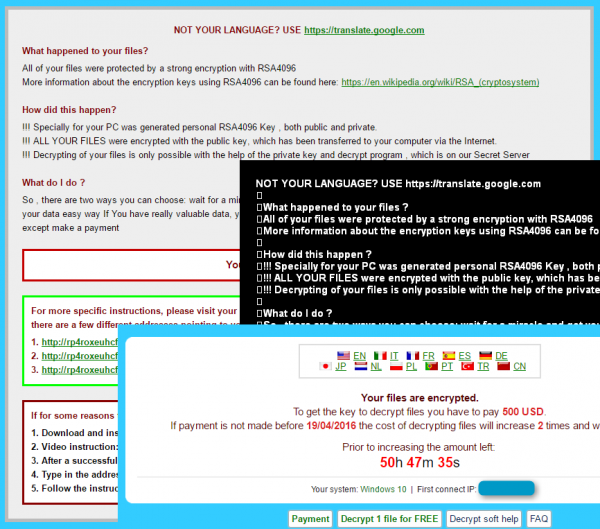A .Crypt extension used to be chiefly associated with a popular application for instant messaging. Currently, it is commonly indicative of Internet scam featuring data hijacking for ransom. The ransomware affects any data stored on a computer system. It applies a sophisticated routine that modifies original code of your files. That is, it encrypts the data with a sophisticated scrambling method.

Once the encryption completes the infection comes up with a message that demands payment for aborting the encryption. The fee is to be paid in bitcoin and via TOR browser. For each transaction, the ransomware creates a unique gateway. That further aggravates identification and detention of the crooks.
Paying the ransom is not the best bargain. The malware is not a self-propelled entity and is dropped into your PC by several unrelated distributors. Apart from spreading the plague, the crooks are in charge of handling the payment of ransom and release of the decryption key. Please note those distributors are unfair by default, as well as tend to have quite restricted computer literacy. Thereby, they may fail to restore the affected data even after their financial demands have been satisfied. That is to say, the victims are advised to apply ransom-free recovery workarounds and get rid of .Crypt encryption virus.
The infection is known to exist in several versions. They apply the same encryption standard and differ in the way they address the users. The oldest versions of the scamware are known to fake an FBI message. It would say that the victim is actually an offender due to visiting some banned websites and grabbing explicit contents. The message prompts to contact the authority, surprisingly, via one of the emails named in a pretty odd way as for the official contact of such a renowned authority.
Recent versions of the ransomware go straight ahead. They do not disguise themselves as tools used by FBI or similar entity. Instead, they interrupt the operation of the computer system with an alert and directly demand the amount ranging around 1 BTC (circa USD 400) to one of the addresses specified.
It is good to have a quite recent backup of your data. If that is the case, the invasion is rather a matter of inconvenience and could be addressed by mere removal of .Crypt virus followed by restoring the affected data from the backups.
In any case, the guidance below will walk you through all the options potentially capable of regaining access to the scrambled info.
Automatic removal of CryptXXX ransomware and .crypt files restoration
The benefits of using the automatic security suite to get rid of this infection are obvious: it scans the entire system and detects all potential fragments of the virus, so you are a few mouse clicks away from a complete fix.
- Download and install recommended malware security suite
- Select Start Computer Scan feature and wait until the utility comes up with the scan report. Proceed by clicking on the Fix Threats button, which will trigger a thorough removal process to address all the malware issues compromising your computer and your privacy.
Unlock .crypt files
CryptXXX ransomware virus represents a unique category of malicious software whose attack surface reaches beyond the operating system and its components, which is why removing the virus itself is a part of the fix only. As it has been mentioned, it encrypts one’s personal information, so the next phase of the overall remediation presupposes reinstating the files that will otherwise remain inaccessible.
-
Launch data recovery software
Similarly to the rest of its fellow-infections, .crypt file virus most likely follows an operational algorithm where it erases the original versions of the victim’s files and actually encrypts their copies. This peculiarity might make your day, because forensics-focused applications like Data Recovery Pro are capable of restoring the information that has been removed. As the virus further evolves, its modus operandi may be altered – in the meanwhile, go ahead and try this.
-
Take advantage of Volume Shadow Copy Service
This technique is based on using the native backup functionality that’s shipped with Windows operating system. Also referred to as Volume Snapshot Service (VSS), this feature makes regular backups of the user’s files and keeps their most recent versions as long as System Restore is on. This ransomware hasn’t been found to affect these copies therefore the restoration vector in question is strongly recommended. The two sub-sections below highlight the automatic and manual workflow.
- a) Use Shadow Explorer
Shadow Explorer is an applet that provides an easy way of retrieving previous versions of files and folders. Its pro’s include an intuitive interface where the computer’s entire file hierarchy is displayed within one window. Just pick the hard disk volume, select the object or directory to be restored, right-click on it and choose Export. Follow the app’s prompts to get the job done.

- b) Use file properties
Essentially, what the above-mentioned Shadow Explorer tool does is it automates the process that can otherwise be performed manually via the Properties dialog for individual files. This particular approach is more cumbrous but just as effective as its software-based counterpart, so you can proceed by right-clicking on a specific file, which has been encrypted by the CryptXXX ransomware, and selecting Properties in the context menu. The tab named Previous Versions is the next thing to click – it displays available versions of the file by date of the snapshot creation. Pick the latest copy and complete the retrieval by following the prompts.

-
Data backups work wonders
Ransomware like this isn’t nearly as almighty and destructive in case you run regular file backups to the cloud or external data media. The virus itself can be completely removed in a matter of minutes, and the distorted information can then be just as easily recovered from the backup. Luckily, this is a growing trend, so ransom Trojans are hopefully going to become less subversive in the near future.
Verify thoroughness of the removal
Having carried out the instructions above, add a finishing touch to the security procedure by running an additional computer scan to check for residual malware activity
